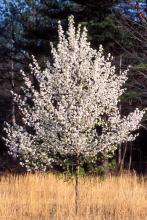Trees, Shrubs and Woody Vines
Media

Species Types
Scientific Name
Fraxinus pennsylvanica
Description
Green ash is one of the most widely planted shade trees around homes and along streets. In the wild, it lives along streams and in low grounds. Sadly, it is one of the trees most vulnerable to the emerald ash borer, an exotic invasive pest.
Media

Species Types
Scientific Name
Quercus bicolor
Description
A beautiful tree, swamp white oak features bicolored leaves that are shiny, dark green above and downy white below. When a breeze sets them in motion, their wavy or lobed shapes add a calm grace to a summer's hike.
Media

Species Types
Scientific Name
Various species in the genus Crataegus
Description
Our state flower, the hawthorn, is solidly represented in Missouri. There are about 100 different kinds of hawthorns that occupy almost every kind of soil in every part of the state. These members of the rose family are closely related to apples.
Media

Species Types
Scientific Name
Ilex decidua
Description
Possum haw, or deciduous holly, is the more common of two native Missouri hollies that lose their leaves each fall. This shrub or small tree is eye-catching in the fall and winter with its bright red berries.
Media

Species Types
Scientific Name
Pyrus calleryana
Description
'Bradford', a type of Callery pear, has been hugely popular in landscaping, but it can escape and hybridize with relatives. Alarmingly, it has become an invasive plant. Learn more about this problem tree.
Media

Species Types
Scientific Name
Platanus occidentalis
Description
The white, smooth-looking limbs of sycamore rise over countless streams and river banks, as well as over sidewalks and city streets. The leaves, which somewhat resemble those of maples, can reach remarkably large sizes.
Media

Species Types
Scientific Name
Acer rubrum
Description
Red maple is one of our most useful — and beautiful — native trees. You can find it in the woods as well as in landscape plantings statewide. Many horticultural varieties are available at nurseries.
Media

Species Types
Scientific Name
Acer saccharinum
Description
In nature, silver maple is a bottomland tree. Silver maples pay for their rapid growth by having rather brittle branches that easily break off in windy and other inclement weather.
Media

Species Types
Scientific Name
Populus deltoides
Description
Named for the cottony fluffs of hairs attached to its tiny seeds, cottonwood thrives in moist lowlands near streams and rivers. It is Missouri’s fastest-growing native tree but pays for that distinction by being relatively short-lived.
Media

Species Types
Scientific Name
Ulmus rubra
Description
Found nearly statewide, slippery elm has fuzzy twigs and reddish hairy buds, which often attract attention in wintertime. Its inner bark is reddish and rather slimy, which gives this tree its name "slippery."
See Also
About Trees, Shrubs and Woody Vines in Missouri
There are no sharp dividing lines between trees, shrubs, and woody vines, or even between woody and nonwoody plants. “Wood” is a type of tissue made of cellulose and lignin that many plants develop as they mature — whether they are “woody” or not. Trees are woody plants over 13 feet tall with a single trunk. Shrubs are less than 13 feet tall, with multiple stems. Vines require support or else sprawl over the ground.





















